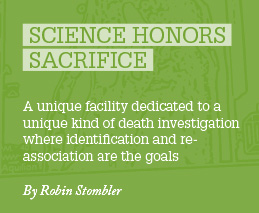
ARP Sciences News
From

August 2017
Magazine,
MENU

In late March 2017, United States Marine Private Harry K. Tye was laid to rest at Arlington National Cemetery – more than seven decades after he was killed in the Pacific Theater during World War II.
His remains had finally been located and identified using DNA sequencing technology. The emotional story ran on the front page of the Washington Post, and the US Secretaries of Defense and Homeland Security were there to honor the private who came home.
Not even 100 miles up the road is the place where many such stories unfold.
The city of Dover, Delaware, is home to the Armed Forces Medical Examiners System (AFMES). Here, forensic science is performed with remarkable proficiency, sensitivity, and innovation. The military base is home to a laboratory that processes and tests dental, skeletal, tissue and hair specimens – the largest of its kind in the world. A database, whose ultimate purpose is to aid in the identification of missing service members from past military conflicts, collects and processes family reference specimens. DNA profiles submitted electronically for upload, storage and searching are processed and automated at such a high level that the laboratory’s global throughput is unmatched.
The majority of scientific and technical personnel for this endeavor come from one company: ARP Sciences. “For 40 years, we have served this major civilian and military mission,” explains Cynthia Thomas, CEO. “We are enormously proud to perform world-changing research and method development in support of identifying missing service members and medical examiners’ investigations into the cause and manner of death of deceased personnel. It’s a humbling experience.”
And it’s a unique challenge for those involved in the death investigations. The bone and tooth fragments this laboratory receives are not typical forensic samples; they may be contaminated, mixed or disassociated. The investigators have established specially designed protocols for handling these precious samples; they must employ specific DNA extraction methods to prevent contamination and customized PCR-based methods to obtain reliable results. Scientist Charla Marshall, who led a team to validate a novel next generation sequencing method for use in processing past accounting specimens, says, “We are the first forensic laboratory to utilize this new technology.”
One of the challenges the laboratory faces is the degradation of DNA. Living cells maintain their DNA by enzymatic repair processes. After death, the cellular compartments that house catabolic enzymes break down and release their contents. Once the DNA molecules themselves start to degrade, whether through lysosomal nucleases, bacteria, fungi, or insects, there is no repair mechanism in place. The damage simply continues to accumulate.
Scientists from ARP Sciences may encounter cases as old as 140 years past death. When so much time has passed, samples are generally fragmented and environmentally challenged. Direct references for the cases are rarely available, so it’s usually necessary to rely on mitochondrial DNA (mtDNA) analysis. mtDNA sequencing provides a high level of success compared to other testing technologies – in fact, its success rate is over 90 percent, much higher than other sequencing techniques like short tandem repeat on the Y-chromosome (Y-STR) and autosomal short tandem repeat (auSTR) testing, which have a success rate just under 50 percent. Why such a significant difference? Nuclear testing relies on the single copy of the nuclear genome, which degrades with age to the point where it can no longer deliver reliable results. Each mitochondrion in the cell has its own mtDNA, meaning an increased likelihood that sequencing will be able to extract usable information.
Mitochondria don’t always hold the answers, though. Sometimes, the laboratory receives small, unidentifiable bone fragments. The first question, of course, is: are they human remains? To find out, the lab uses 12S rRNA gene testing. Since the implementation of this testing protocol, 45 percent of samples tested were found to be non-human – helping investigators work out which ones need continued investigation.
Samples at the laboratory vary from the highly challenging to the quite ordinary. Routine samples may include human remains and reference samples. The former are usually bones, teeth, tissue, hair, dentures, envelopes and clothing (with body fluid stains like saliva and blood extracted from the latter two). Reference samples include bloodstain cards and buccal swabs, from both subjects and family members.
Bloodstain cards became standard in the early 1990s, shortly after Operation Desert Storm. At that point, the US Department of Defense began collecting blood specimens from military service personnel. A quality control process for extracting DNA from the cards, which are solely used to identify remains, had to be developed and implemented. The DNA must be collected in such a way that its integrity is maintained and the test results are meaningful and legally defensible – so how do they do it? Samples must be labeled and stored separately in appropriate containers, and personnel must change their tools and personal protective equipment between each collection. Despite the rigorous protocols, though, not every forensic sample leads to a new identification; samples might have degraded, remains commingled, there might not be appropriate references, and it’s possible that a submitted sample may not be of human origin.
But even with these caveats, advancements in forensic science have come so far so fast that there may never be another truly unknown soldier. In 1972, an Air Force pilot was shot down in Vietnam. The remains of this Vietnam War Unknown were laid to rest in the Tomb of the Unknown Soldier at Arlington National Cemetery. This would once have been the end of the soldier’s story – but in 1998, his remains were exhumed. With mtDNA testing, AFMES was able to identify the remains of First Lieutenant Michael J. Blassie, United States Air Force. The crypt of the Vietnam Unknown is now vacant.
Robin Stombler is President of Auburn Health Strategies, Arlington, USA.
ARP SCIENCES LLC
9210 Corporate Blvd. Suite 120, Rockville, MD 20850
Web site designed by Paige Powell, ArtByPaige.com